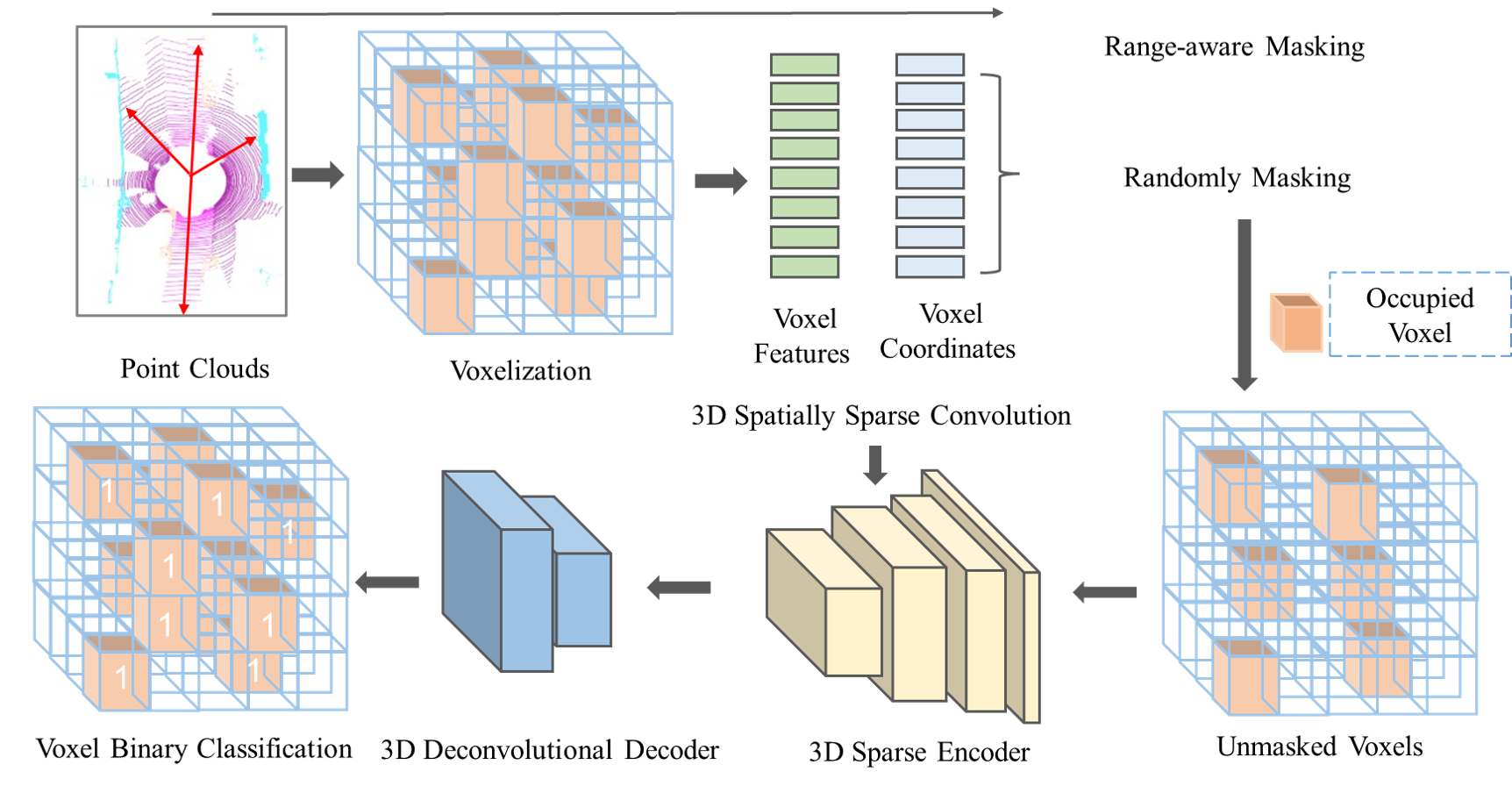Occupancy-MAE: Self-supervised Pre-training Large-scale LiDAR Point Clouds with Masked Occupancy Autoencoders
Repository for our arxiv paper "Occupancy-MAE: Self-supervised Pre-training Large-scale LiDAR Point Clouds with Masked Occupancy Autoencoders".
Mask-based pre-training has achieved great success for self-supervised learning in images and languages without manually annotated supervision. However, it has not yet been studied for large-scale point clouds with redundant spatial information. In this research, we propose a mask voxel autoencoder network for pre-training large-scale point clouds, dubbed Voxel-MAE. Our key idea is to transform the point clouds into voxel representations and classify whether the voxel contains point clouds. This simple but effective strategy makes the network voxel-aware of the object shape, thus improving the performance of downstream tasks, such as 3D object detection. Our Voxel-MAE, with even a 90% masking ratio, can still learn representative features for the high spatial redundancy of large-scale point clouds. We also validate the effectiveness of Voxel-MAE on unsupervised domain adaptative tasks, which proves the generalization ability of Voxel-MAE. Our Voxel-MAE proves that it is feasible to pre-train large-scale point clouds without data annotations to enhance the perception ability of the autonomous vehicle. Extensive experiments show great effectiveness of our pre-training method with 3D object detectors (SECOND, CenterPoint, and PV-RCNN) on three popular datasets (KITTI, Waymo, and nuScenes).
Please refer to INSTALL.md for the installation of OpenPCDet(v0.5).
Please refer to GETTING_STARTED.md .
KITTI:
Train with multiple GPUs:
bash ./scripts/dist_train_voxel_mae.sh ${NUM_GPUS} --cfg_file cfgs/kitti_models/voxel_mae_kitti.yaml --batch_size ${BATCH_SIZE}
Train with a single GPU:
python3 train_voxel_mae.py --cfg_file cfgs/kitti_models/voxel_mae_kitti.yaml --batch_size ${BATCH_SIZE}
Waymo:
python3 train_voxel_mae.py --cfg_file cfgs/kitti_models/voxel_mae_waymo.yaml --batch_size ${BATCH_SIZE}
nuScenes:
python3 train_voxel_mae.py --cfg_file cfgs/kitti_models/voxel_mae_nuscenes.yaml --batch_size ${BATCH_SIZE}
Same as OpenPCDet with pre-trained model from our Voxel-MAE.
bash ./scripts/dist_train.sh ${NUM_GPUS} --cfg_file cfgs/kitti_models/second.yaml --batch_size ${BATCH_SIZE} --pretrained_model ../output/kitti/voxel_mae/ckpt/check_point_10.pth
The results are the 3D detection performance of moderate difficulty on the val set of KITTI dataset. Results of OpenPCDet are from here .
| Car@R11 | Pedestrian@R11 | Cyclist@R11 | |
|---|---|---|---|
| SECOND | 78.62 | 52.98 | 67.15 |
| Voxel-MAE+SECOND | 78.90 | 53.14 | 68.08 |
| SECOND-IoU | 79.09 | 55.74 | 71.31 |
| Voxel-MAE+SECOND-IoU | 79.22 | 55.79 | 72.22 |
| PV-RCNN | 83.61 | 57.90 | 70.47 |
| Voxel-MAE+PV-RCNN | 83.82 | 59.37 | 71.99 |
Similar to OpenPCDet , all models are trained with a single frame of 20% data (~32k frames) of all the training samples , and the results of each cell here are mAP/mAPH calculated by the official Waymo evaluation metrics on the whole validation set (version 1.2).
| Performance@(train with 20% Data) | Vec_L1 | Vec_L2 | Ped_L1 | Ped_L2 | Cyc_L1 | Cyc_L2 | Voxel-MAE | 3D Detection |
|---|---|---|---|---|---|---|---|---|
| SECOND | 70.96/70.34 | 62.58/62.02 | 65.23/54.24 | 57.22/47.49 | 57.13/55.62 | 54.97/53.53 | ||
| Voxel-MAE+SECOND | 71.12/70.58 | 62.67/62.34 | 67.21/55.68 | 59.03/48.79 | 57.73/56.18 | 55.62/54.17 | ||
| CenterPoint | 71.33/70.76 | 63.16/62.65 | 72.09/65.49 | 64.27/58.23 | 68.68/67.39 | 66.11/64.87 | ||
| Voxel-MAE+CenterPoint | 71.89/71.33 | 64.05/63.53 | 73.85/67.12 | 65.78/59.62 | 70.29/69.03 | 67.76/66.53 | ||
| PV-RCNN (AnchorHead) | 75.41/74.74 | 67.44/66.80 | 71.98/61.24 | 63.70/53.95 | 65.88/64.25 | 63.39/61.82 | ||
| Voxel-MAE+PV-RCNN (AnchorHead | 75.94/75.28 | 67.94/67.34 | 74.02/63.48 | 64.91/55.57 | 67.21/65.49 | 64.62/63.02 | ||
| PV-RCNN (CenterHead) | 75.95/75.43 | 68.02/67.54 | 75.94/69.40 | 67.66/61.62 | 70.18/68.98 | 67.73/66.57 | ||
| Voxel-MAE+PV-RCNN (CenterHead) | 77.29/76.81 | 68.71/68.21 | 77.70/71.13 | 69.53/63.46 | 70.55/69.39 | 68.11/66.95 | ||
| PV-RCNN++ | 77.82/77.32 | 69.07/68.62 | 77.99/71.36 | 69.92/63.74 | 71.80/70.71 | 69.31/68.26 | ||
| Voxel-MAE+PV-RCNN++ | 78.23/77.72 | 69.54/69.12 | 79.85/73.23 | 71.07/64.96 | 71.80/70.64 | 69.31/68.26 |
| mAP | NDS | mATE | mASE | mAOE | mAVE | mAAE | |
|---|---|---|---|---|---|---|---|
| SECOND-MultiHead (CBGS) | 50.59 | 62.29 | 31.15 | 25.51 | 26.64 | 26.26 | 20.46 |
| Voxel-MAE+SECOND-MultiHead | 50.82 | 62.45 | 31.02 | 25.23 | 26.12 | 26.11 | 20.04 |
| CenterPoint (voxel_size=0.1) | 56.03 | 64.54 | 30.11 | 25.55 | 38.28 | 21.94 | 18.87 |
| Voxel-MAE+CenterPoint | 56.45 | 65.02 | 29.73 | 25.17 | 38.38 | 21.47 | 18.65 |
Our codes are released under the Apache 2.0 license.
This repository is based on OpenPCDet.
If you find this project useful in your research, please consider cite:
@ARTICLE{Occupancy-MAE,
title={Voxel-MAE: Masked Autoencoders for Pre-training Large-scale Point Clouds},
author={Chen Min, Xinli Xu, Dawei Zhao, Liang Xiao, Yiming Nie, and Bin Dai},
journal = {arXiv e-prints},
year={2022}
}
